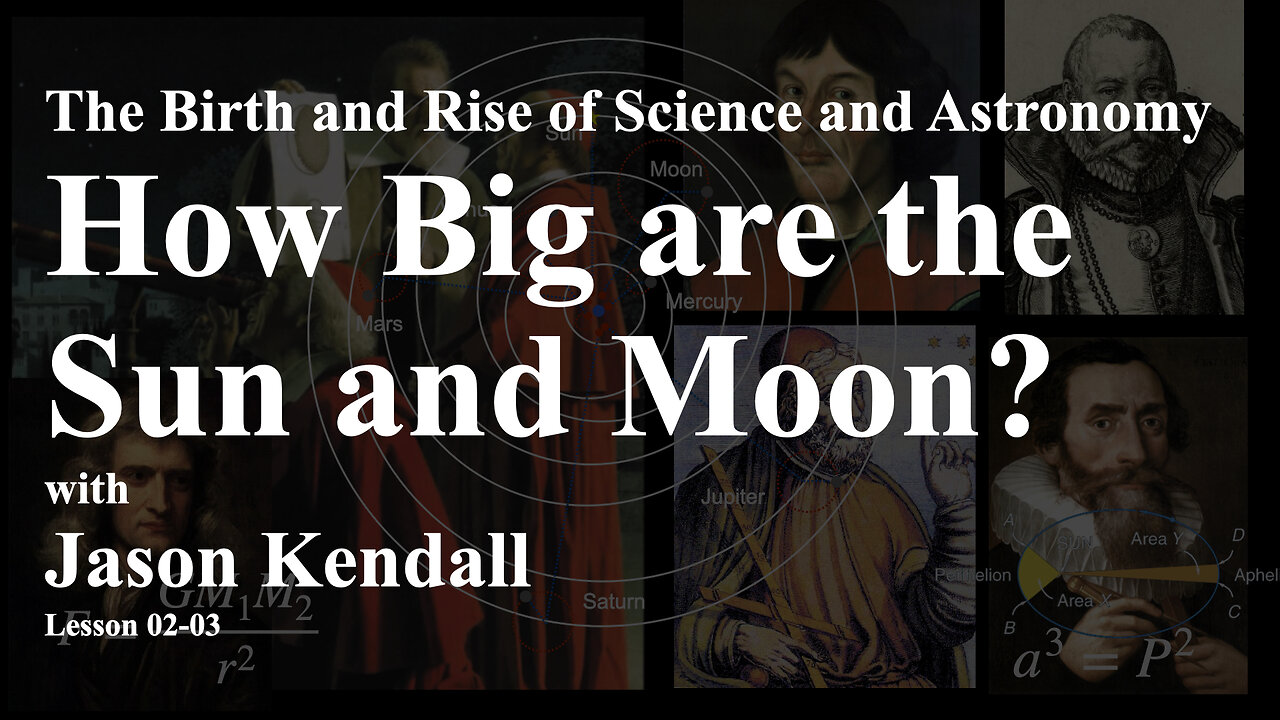Premium Only Content

Estimating Celestial Distances: The Contributions of Aristarchus of Samos
In continuation of our previous discourse regarding astronomical distances and dimensions, we shall now examine the methodologies employed by ancient astronomers in estimating the relative distances between the Earth, Moon, and Sun. Our focal point will be Aristarchus of Samos, a prominent figure who lived from 310 BC to 230 BC. Aristarchus utilized fundamental geometric principles to ascertain these distances and their relative proportions. He made observations of the lunar phases, particularly during the first quarter, thereby constructing a right triangle involving the Earth, Moon, and Sun, with the Moon positioned at the 90-degree vertex. By measuring the angular separation between the Moon and the Sun during the first quarter phase, Aristarchus calculated this angle to be approximately 87 degrees (though it is more accurately about 89 degrees and 51 minutes). Employing this angular measurement, he deduced that the distance to the Sun was roughly 19 times greater than that of the Moon’s distance from Earth. This finding indicated that the Sun was significantly farther away and, consequently, much larger than the Moon. Furthermore, by timing the duration of lunar eclipses, he postulated that the Moon’s diameter was approximately half that of the Earth. Although his measurements lacked the precision that modern standards demand, Aristarchus made notable advancements in the comprehension of relative sizes and distances in astronomy, positing that the Sun was vastly larger than both the Earth and the Moon. These pioneering observations and calculations laid the foundation for subsequent astronomical techniques. Despite the considerable errors inherent in Aristarchus’s measurements, his work established a pivotal groundwork for understanding celestial distances and the scale of our solar system. Our forthcoming discussion will explore the historical debates surrounding the heliocentric model and the compelling evidence supporting Earth’s motion around the Sun, a crucial inquiry that has profoundly influenced contemporary astronomy.
-
 LIVE
LIVE
SpartakusLIVE
10 hours agoTOXIC Solos on ARC Raiders || Friday Night HYPE - WZ or Redsec Later?
459 watching -
 2:15:42
2:15:42
TheSaltyCracker
2 hours agoWoke is DEAD ReeEEStream 11-07-25
42.4K119 -
 LIVE
LIVE
Sarah Westall
2 hours agoThe City of London: Infiltration, Intimidation & Centralized Power w/ Mike Harris
547 watching -
 10:14:18
10:14:18
Dr Disrespect
12 hours ago🔴LIVE - DR DISRESPECT - ARC RAIDERS - AGAINST ALL DANGER
147K22 -
 32:09
32:09
ThisIsDeLaCruz
23 hours agoFalling In Reverse: Christian Thompson’s Stage Tech Revealed
3.25K2 -
 LIVE
LIVE
SynthTrax & DJ Cheezus Livestreams
1 day agoFriday Night Synthwave 80s 90s Electronica and more DJ MIX Livestream 80s Night / Late Night Nostalgia
277 watching -
 4:05:52
4:05:52
Nerdrotic
7 hours ago $0.15 earnedHollywood REGRET | Disney's Predator | The Feminist Avengers - Friday Night Tights 379
36.9K12 -
 DVR
DVR
Mally_Mouse
4 days agoFriend Friday!! 🎉 - Let's Play! - MIMESIS
5.13K2 -
 41:20
41:20
MattMorseTV
3 hours ago $0.19 earned🔴Schumer just BACKSTABBED his OWN VOTERS. 🔴
18.9K39 -
 3:33:34
3:33:34
MissesMaam
4 hours ago*Spicy* Friend Friday with Mally_Mouse!! 💚✨
2.71K3